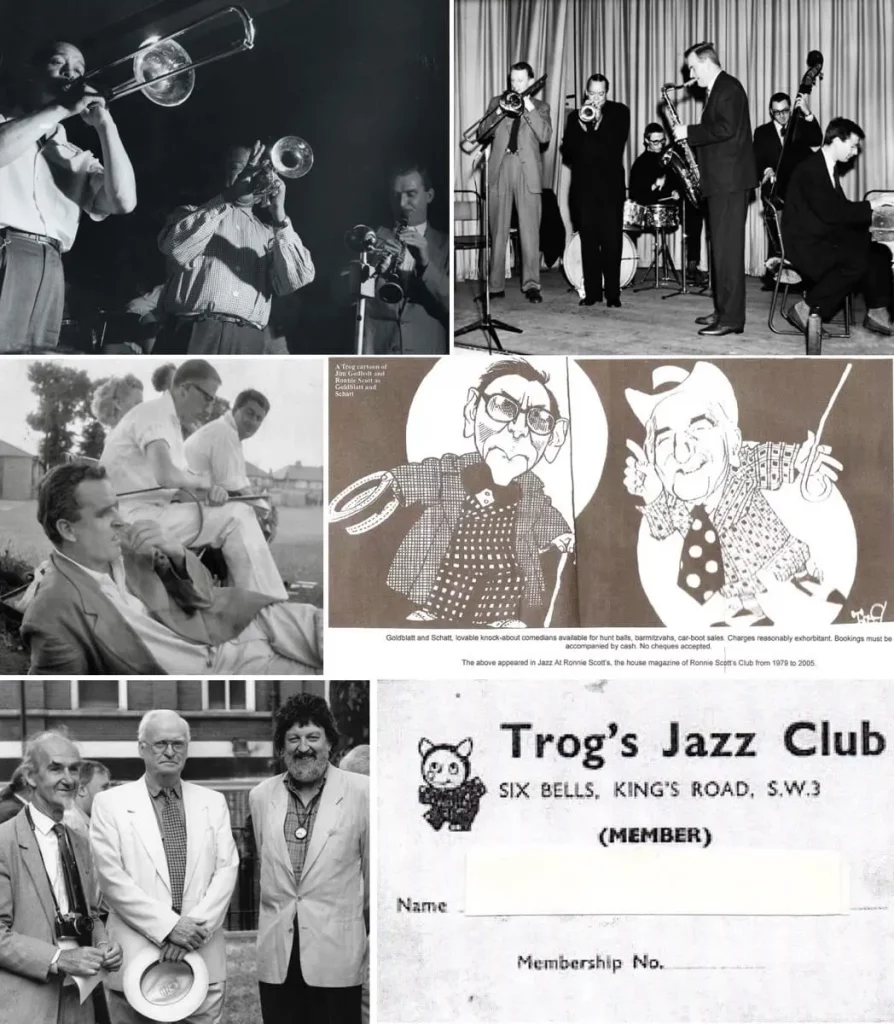In the jazz world, clarinettist Wally Fawkes was well known for his association with Humphrey Lyttelton, but he will also be remembered as a successful cartoonist, caricaturist and illustrator.
He was born in Vancouver, British Columbia in 1924. His family moved to Britain in 1931 and he got a scholarship to attend Sidcup School of Art. During the war he was employed painting camouflage and working on maps of coal seams for the Coal Commission, after which he joined the Clement Davies Advertising Agency.
This was followed by the Daily Mail, where his comic strip Flook first appeared in 1949, under his pen-name, Trog, short for troglodyte, after his time spent in underground air-raid shelters. A satire on British politics, it lasted 35 years, using George Melly, Humphrey Lyttelton, Barry Humphries and Barry Took as script collaborators. He was to also contribute to Punch, The New Statesman, The Observer, Private Eye and The Oldie, amongst others.
In 1944 he had joined George Webb’s Dixielanders, then managed by Jim Godbolt, playing regularly at the Red Barn in Barnehurst. Godbolt also lived in Sidcup and both men had been members of the Rhythm Club 161 which met at the Station Hotel, Sidcup, in the early 40s. Lyttelton, whom Wally had known through Camberwell Art College, was recruited to the band but left in 1948, taking Wally with him and they gradually moved over to mainstream jazz rather than revivalist.
Wally modelled his style of playing on that of Sidney Bechet, favouring a broad tone, volume and vibrato to such a point that on hearing Wally play, Bechet announced “There goes my shadow.” Wally was one of the musicians that appeared at the “forbidden” performance of Bechet in November 1949 at the Winter Gardens Theatre, London. It was in that year that he married his first wife, journalist Sandy Fawkes (née Boyce-Carmichelle).

After leaving Lyttelton in 1956 Fawkes played with several bands, including that of pianist Johnny Parker, and with Godbolt started a regular session at the Six Bells, Chelsea, a musicians’ drinking haunt around the corner from the Chenil Galleries, where bands had recorded since the 30s. The club became known as Trog’s Club and ran for 10 years. Wally played there with his band, The Troglodytes, and many other visiting musicians including Henry Red Allen, Bill Coleman and Ben Webster. He later played with John Chilton’s Feetwarmers and often with pianist Stan Greig, as well as reconnecting with Humphrey Lyttelton.
Wally was also a keen cricketer, and with George Webb, back in the 40s, decided that the Lyttelton Club (later the 100 Club) needed a team and consequently the Ravers Cricket Club was formed, consisting of musicians and members of the jazz fraternity. According to Godbolt, who also played in the team, Wally was an elegant batsman, a medium-fast bowler (his best figures were 5-42 against Vic Lewis’ XI in 1961) but a “sluggardly fielder”. He eventually left the side when he claimed that “his left leg coming heavily down the popping crease was making it progressively shorter and he would have to retire before it disappeared entirely”. He retained his interest in the game throughout his life. When a small group of us walked up to Hampstead Heath in 2013 to scatter Godbolt’s remains, I noticed Wally had an earpiece plugged into a small radio and asked him what he was listening to. “Cricket,” he appropriately replied – “the Ashes.”
It was Godbolt who probably knew him the longest and possibly better than most, describing him as “highly popular and engaging, with an insouciant magnetism. He achieved many things without ever seeming to try very hard . . . a master of the offhand barb and the seemingly innocuous thrust.” This often manifested itself in his storylines, where many of the characters in Flook were perceptively based on people in the jazz world, including Godbolt himself, much to his amusement, as Len Bloggs, a snarling anti-social inverted snob with a chip on his shoulder.
In later life, Wally suffered from increasing sight problems and had to give up his illustrative work. He did continue to play, and one of his last performances was at the Mansfield, Tufnell Park in 2011. A testimony to the broad respect in which he was held was the presence of the late Lol Coxhill, who went to hear one of his boyhood heroes and a mainstay of British jazz.
Wally was a fine musician and a warm and humorous raconteur. Our thoughts go to his wife, Susan Clifford, and to his children and family.
Walter Ernest Fawkes (21 June 1924 – 1 March 2023)
















